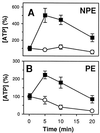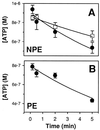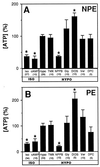A release mechanism for stored ATP in ocular ciliary epithelial cells
- PMID: 9618558
- PMCID: PMC22777
- DOI: 10.1073/pnas.95.12.7174
A release mechanism for stored ATP in ocular ciliary epithelial cells
Abstract
Purines can modify ciliary epithelial secretion of aqueous humor into the eye. The source of the purinergic agonists acting in the ciliary epithelium, as in many epithelial tissues, is unknown. We found that the fluorescent ATP marker quinacrine stained rabbit and bovine ciliary epithelia but not the nerve fibers in the ciliary bodies. Cultured bovine pigmented and nonpigmented ciliary epithelial cells also stained intensely when incubated with quinacrine. Hypotonic stimulation of cultured epithelial cells increased the extracellular ATP concentration by 3-fold; this measurement underestimates actual release as the cells also displayed ecto-ATPase activity. The hypotonically triggered increase in ATP was inhibited by the Cl--channel blocker 5-nitro-2-(3-phenylpropylamino)benzoic acid (NPPB) in both cell types. In contrast, the P-glycoprotein inhibitors tamoxifen and verapamil and the cystic fibrosis transmembrane conductance regulator (CFTR) blockers glybenclamide and diphenylamine-2-carboxylate did not affect ATP release from either cell type. This pharmacological profile suggests that ATP release is not restricted to P-glycoprotein or the cystic fibrosis transmembrane conductance regulator, but can proceed through a route sensitive to NPPB. ATP release also was triggered by ionomycin through a different NPPB-insensitive mechanism, inhibitable by the calcium/calmodulin-activated kinase II inhibitor KN-62. Thus, both layers of the ciliary epithelium store and release ATP, and purines likely modulate aqueous humor flow by paracrine and/or autocrine mechanisms within the two cell layers of this epithelium.
Figures




Similar articles
-
Adenosine stimulates Cl- channels of nonpigmented ciliary epithelial cells.Am J Physiol. 1997 Oct;273(4):C1354-61. doi: 10.1152/ajpcell.1997.273.4.C1354. Am J Physiol. 1997. PMID: 9357781
-
PGE(2), Ca(2+), and cAMP mediate ATP activation of Cl(-) channels in pigmented ciliary epithelial cells.Am J Physiol Cell Physiol. 2001 Nov;281(5):C1614-23. doi: 10.1152/ajpcell.2001.281.5.C1614. Am J Physiol Cell Physiol. 2001. PMID: 11600425
-
Pathways for ATP release by bovine ciliary epithelial cells, the initial step in purinergic regulation of aqueous humor inflow.Am J Physiol Cell Physiol. 2010 Dec;299(6):C1308-17. doi: 10.1152/ajpcell.00333.2010. Epub 2010 Oct 6. Am J Physiol Cell Physiol. 2010. PMID: 20926783 Free PMC article.
-
Basis of chloride transport in ciliary epithelium.J Membr Biol. 2004 Jul 1;200(1):1-13. doi: 10.1007/s00232-004-0688-5. J Membr Biol. 2004. PMID: 15386155 Review.
-
The fall and rise of active chloride transport: implications for regulation of intraocular pressure.J Exp Zool A Comp Exp Biol. 2003 Nov 1;300(1):5-13. doi: 10.1002/jez.a.10303. J Exp Zool A Comp Exp Biol. 2003. PMID: 14598380 Review.
Cited by
-
Dose-dependent ATP depletion and cancer cell death following calcium electroporation, relative effect of calcium concentration and electric field strength.PLoS One. 2015 Apr 8;10(4):e0122973. doi: 10.1371/journal.pone.0122973. eCollection 2015. PLoS One. 2015. PMID: 25853661 Free PMC article.
-
Volume-regulated anion channels serve as an auto/paracrine nucleotide release pathway in aortic endothelial cells.J Gen Physiol. 2002 Jun;119(6):511-20. doi: 10.1085/jgp.20028540. J Gen Physiol. 2002. PMID: 12034759 Free PMC article.
-
SLC10A4 regulates IgE-mediated mast cell degranulation in vitro and mast cell-mediated reactions in vivo.Sci Rep. 2017 Apr 24;7(1):1085. doi: 10.1038/s41598-017-01121-8. Sci Rep. 2017. PMID: 28439090 Free PMC article.
-
Enhanced inflow and outflow rates despite lower IOP in bestrophin-2-deficient mice.Invest Ophthalmol Vis Sci. 2009 Feb;50(2):765-70. doi: 10.1167/iovs.08-2501. Epub 2008 Oct 20. Invest Ophthalmol Vis Sci. 2009. PMID: 18936135 Free PMC article.
-
ATP release via anion channels.Purinergic Signal. 2005 Dec;1(4):311-28. doi: 10.1007/s11302-005-1557-0. Epub 2005 Dec 3. Purinergic Signal. 2005. PMID: 18404516 Free PMC article.
References
-
- Krupin T, Civan M M. In: The Glaucomas. 2nd Ed. Ritch R, Shields M B, Krupin T, editors. St. Louis: Mosby; 1995. pp. 251–280.
-
- Bowler J M, Peart D, Purves R D, Carré D A, Macknight A D C, Civan M M. Exp Eye Res. 1996;62:131–139. - PubMed
-
- Civan M M. News Physiol Sci. 1997;12:158–162.
-
- Wax M, Sanghavi D M, Lee C H, Kapadia M. Exp Eye Res. 1993;57:89–95. - PubMed
-
- Carré D A, Mitchell C H, Peterson-Yantorno K, Coca-Prados M, Civan M M. Am J Physiol. 1997;273:C1354–C1361. - PubMed
Publication types
MeSH terms
Substances
Grants and funding
LinkOut - more resources
Full Text Sources
Other Literature Sources

